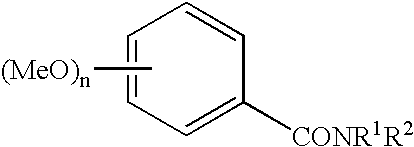Compounds as PDE IV and TNF Inhibitors
a technology of which is applied in the field of compound as pde iv and tnf inhibitors, can solve the problems of not disclosing or suggesting that the benzamido moiety may be substituted by anything other than methoxy
- Summary
- Abstract
- Description
- Claims
- Application Information
AI Technical Summary
Benefits of technology
Problems solved by technology
Method used
Image
Examples
example 1
COMPOUNDS A-BH
[0362]A suspension of 3-cyclopentyloxy-6-fluoro-4-methoxybenzoic acid (0.88 g) in dry toluene (10 mL) is treated with thionyl chloride (2 mL) and the mixture is refluxed for 90 minutes. The mixture is cooled and concentrated in vacuo, to give “yellow oil A”.
[0363]A suspension of sodium hydride (0.4 g of a 60% dispersion in mineral oil) in dimethylformamide (5 mL) is treated with a solution of 4-amino-3,5-dichloropyridine (0.82 g) in dimethylformamide (5 mL) and the reaction mixture is stirred at room temperature for 30 minutes. It is then treated with a solution of the “yellow oil A” in dimethylformamide (5 mL) and stirred at 45° C. for 16 hours. It is then cooled, poured into water (50 mL) and extracted with chloroform (3×500 mL). The combined extracts are dried over magnesium sulphate and concentrated. The residual yellow oil is subjected to flash chromatography [a 3:1 mixture of petroleum ether (b.p. 60-80° C.) and ethyl acetate is used as eluent in a silica gel col...
example 2
COMPOUNDS BI-BJ
[0424]A solution of 4-amino-3,5-dichloropyridine (3.73 g) in dry tetrahydrofuran (50 mL) under nitrogen at 5-10° C. is treated portionwise with sodium hydride (60% dispersion in oil; 1.87 g). After 30 minutes it is treated dropwise with a solution of 3-cyclopent-2-enyloxy-4-methoxybenzoyl chloride in dry tetrahydrofuran (50 mL; that is prepared, as described in Reference Example 6, from 5.89 g 3-cyclopent-2-enyloxy-4-methoxybenzoic acid). The resulting mixture is allowed to warm to room temperature and left to stand overnight. Most of the solvent is then removed under reduced pressure and the residue is partitioned between water (250 mL) and dichloromethane (250 mL) and the aqueous layer is further extracted with dichloromethane (2×250 mL). The combined organic layers are dried over sodium sulfate, the solvent is removed under reduced pressure, and the resulting residue is subjected to flash chromatography on silica gel, eluting with mixtures of ethyl acetate and pent...
example 3
COMPOUNDS BK-BL
[0426]A solution of 4-amino-3,5-dichloropyridine (0.93 g) in dry tetrahydrofuran (56 mL) under nitrogen at 5-10° C. is treated portionwise with sodium hydride (60% dispersion in oil, 0.57 g). After 1 hour it is treated dropwise with a solution of 3-cyclopent-3-enyloxy-4-methoxybenzoyl chloride in dry tetrahydrofuran (30 mL) that is prepared as described in Reference Example 7 from 1.33 g 3-cyclopent-3-enyloxy-4-methoxybenzoic acid. The resulting mixture is allowed to warm to room temperature, stirred for a further 3 hours and then poured into 5% aqueous potassium carbonate (430 mL). The resulting emulsion is extracted with ethyl acetate (3×150 mL), the combined organic extracts washed with water (2×20 mL), followed by ice-cold 1 M aqueous hydrochloric acid (2×20 mL) and dried over sodium sulfate. The solvent is removed under reduced pressure and the resulting residue subject to flash chromatography on silica gel, eluting with mixtures of t-butyl methyl ether and cyclo...
PUM
 Login to View More
Login to View More Abstract
Description
Claims
Application Information
 Login to View More
Login to View More - R&D
- Intellectual Property
- Life Sciences
- Materials
- Tech Scout
- Unparalleled Data Quality
- Higher Quality Content
- 60% Fewer Hallucinations
Browse by: Latest US Patents, China's latest patents, Technical Efficacy Thesaurus, Application Domain, Technology Topic, Popular Technical Reports.
© 2025 PatSnap. All rights reserved.Legal|Privacy policy|Modern Slavery Act Transparency Statement|Sitemap|About US| Contact US: help@patsnap.com



